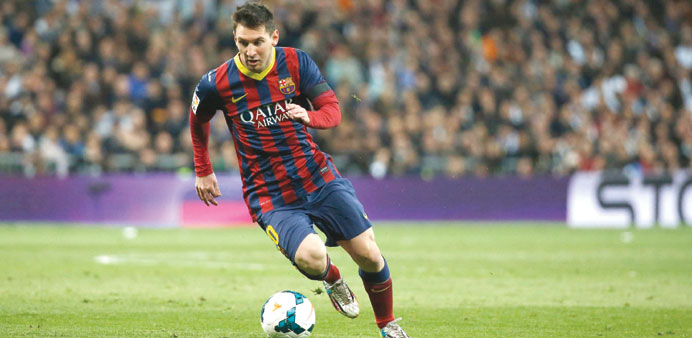Argentina and Barcelona striker Lionel Messi seems to having a bad run of form looking at his performances against Atletico Madrid in the Champions League and Real Madrid in the King’s Cup final.
Jonathan Wilson, theguardian.com/London
Football is always, ultimately, about compromise. Everything had been looking rosy for Argentina, who had qualified for the World Cup for once with games to spare and the sense of a cohesive team coming together, but then the injuries began. When the draw is made, the World Cup exists in a world of perfect possibility and you imagine every player at peak form and fitness, but it is never like that, and the job of a manager is always to balance the idea with what is possible.
The panic over Sergio Aguero’s hamstring has begun to subside although there is no doubt that Alejandro Sabella, the national coach, would like to see him complete at least a couple of Manchester City’s games before the end of the season. A new concern sprang up last week about Lionel Messi: what was behind his lacklustre display for Barcelona against Atletico Madrid in the Champions League? Was he injured? Is he exhausted? Is he already dreaming of glory in the Maracan? And then, on Monday, came a far more concrete concern as Fernando Gago damaged his left knee in Boca Juniors’ 0-0 draw against Coln.
The initial news was bad, with Boca’s doctor, Jorge Batista, detailing a grade two sprain with partial lesion of the medial collateral ligament in the left knee and recommending 15 days in a splint, which, together with rehabilitation, he estimated would keep the player out for 60 days: that is, until a day after the World Cup begins. Further diagnosis by the national team medical staff is slightly more positive and there is hope that Gago will be fit for the friendly against Slovenia in La Plata on 7 June, which would give him another eight days before Argentina begin their World Cup campaign against Bosnia Herzegovina in Rio de Janeiro.
Gago may not have quite the star quality of Messi or Agero but his importance to Argentina is enormous. As qualifying progressed, Sabella, apparently influenced by Messi, gradually came to prefer a 4-3-3. A putative first XI would probably read: Sergio Romero; Pablo Zabaleta, Federico Fernandez, Ezequiel Garay, Marcos Rojo; Fernando Gago, Javier Mascherano, Angel di Mara; Lionel Messi, Gonzalo Higuan, Sergio Aguero (they came closest to fielding that side in the 0-0 friendly draw away to Romania in March, when Garay was replaced by Jos Mara Basanta).
The strength of the side is the front three but Sabella’s success has been to build a solid platform for it. The back four is perhaps a little rickety but the midfield sustains it. Mascherano is a fine ball-winner, his understanding of defensive positioning enhanced by operating as a central defender at Barcelona. Di Mara, creative and diligent, provides a vital role in shuttling up and down the left, linking the back seven and the front three. Gago, meanwhile, has the engine and the brain either to get forward to support the forward line, or to drop in and cover if Zabaleta surges forward in a way that Rojo will not on the left.
Gago is one of the forgotten men on world football, his time at Real Madrid ultimately ravaged by injury. He seems somehow far older than he is, but he only turned 28 last week, and he was part of the Argentina side alongside Messi, Agero, Garay and Zabaleta that won the Under-20 World Cup in 2005. Injuries perhaps have meant he has never quite hit the heights he might have done but he remains a player of high quality, and there is no obvious replacement. Lucas Biglia, another veteran of that 2005 side, could come in but he is a more overtly defensive player and, when used in the qualifiers, tended to take Mascherano’s place. Or there is Ever Banega, more of a like-for-like replacement, but perhaps lacking the tenacity of Gago.
And then there is the eternal issue of Carlos Tevez, who has not played for Argentina since the quarter-final of the Copa America against Uruguay in 2011, when he sulked his way through 38 minutes as a substitute, got booked and missed his penalty in the shootout. He has been in superb form for Juventus this season but seems no closer to forcing himself into Sabella’s squad.
A cleverly orchestrated media campaign eventually persuaded Julio Grondona, the president of the Argentinian football association, to pressure the then national coach, Sergio Batista, into recalling him just before the Copa America and it is difficult not to wonder whether an interview Tevez gave to Cronica on Wednesday was part of a similar process. “Everybody asks why I’m not [in the squad],” he said. “But I shouldn’t answer that question as it would be disrespectful to Sabella. Things are as they are, full stop.”
He also insisted that, despite persistent reports, there has been no falling out with Messi. “I don’t know where such a ludicrous idea came from,” he said. “All these things have been written and the truth is that Messi has called me 10 times. We’ve spent time together, played in practices and games and never had a difference. He’s a delightful and very educated person. This should be his World Cup and I hope that it will be with all my heart because he’s a wonderful player.”
True or not and given their performances together at the Copa America, it’s fair to say there have been at least tactical issues between Messi and Tevez placing the onus for the latter’s absence on the manager is a smart political move, paving the way for a potential return after the World Cup, when Sabella will be gone.
On Tevez, the coach’s mind seems made up. With Gago, though, Sabella will just have to wait.



